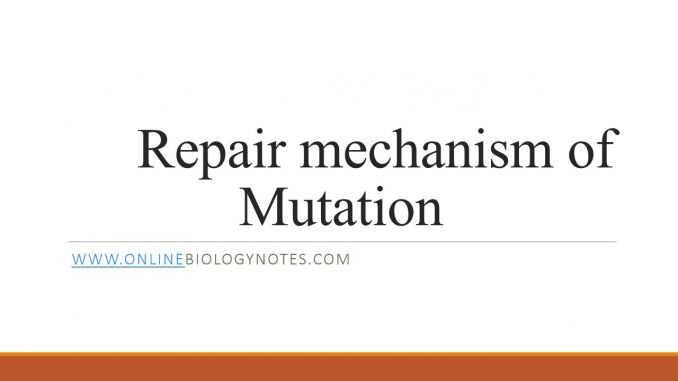
Repair mechanism of mutation
- Repair system play a significant role in mutation process. As a result of repair, potentially lethal changes in DNA may be eliminated. If the repair system function in error free manner, potentially mutagenic lesions are eliminated before they can be converted into final mutation.
Following are the repair mechanism
- Photoreactivation
- Excision repair system
- Post replicative recombination repair
- Adaptive repair
- SOS repair
1. Photo reactivation
- Ultraviolet light is a physical mutagen and can induce mutation. Ultra violet radiation (254 nm) causes formation of pyrimidine dimers (cyclobutane ring), when two pyrimidine bases occurs together in single strand of DNA.
- Thymine dimer is most common one but cytosine dimer as well as thymine-cytosine may also occurs. Thymine dimer is a state in which two adjacent thymine molecules are chemically joined distorting the structure of DNA, so that impeding transcription and replication process.
- This pyrimidine dimer formation is lethal to the cell unless it is corrected. A repair mechanism known as photo reactivation can repair this mutation.
- When UV radiated population of bacteria is subsequently exposed to visible light of wave length of 300-450nm, the survival rate increases and frequency of mutation decreases. This is due to activation of photo reactivating enzyme photolyase, which splits thymine dimer.
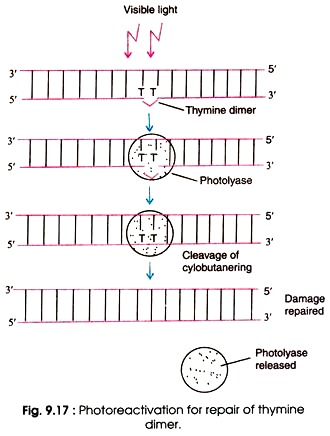
- In the dark, the enzyme bind with thymine dimer and in presence of visible light the enzyme split the thymine dimers.
- Upto 80% of thymine dimers existing in genome can be photoreactivated.
2. Excision repair system
- The repair system remove and replace the altered bases from damaged DNA. Excision repair system involves nucleotide repair and base excision repair.
i. Base excision repair:
- In this mechanism modified bases are recognized and cut out. Mutation causes alkylation and deamination of bases which are recognized by special DNA glycosylase enzyme.
- Glycosylase recognizes and remove the damaged bases by hydrolyzing the glycosidic bond and cut out the damaged base creating AP site (a purinic or pyrimidinic site).
- The AP site is recognized by AP endonucleases which split the phosphodiester bond on DNA strand at AP site and removes the AP sugar.
- After the damaged nucleotide is removed, the gap is repair by DNA polymerase I and ligated by DNA ligase.
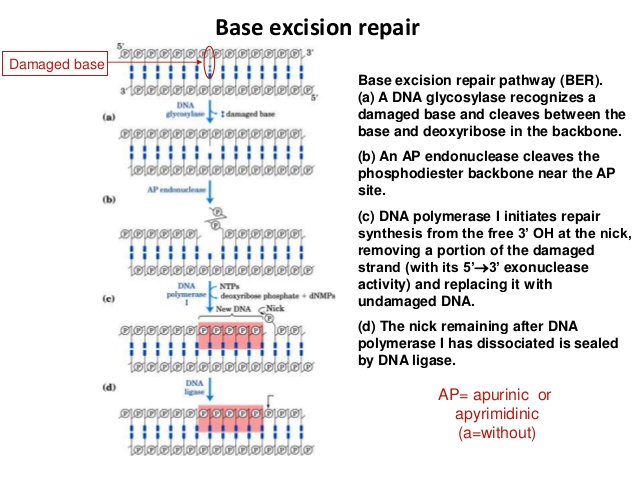 figure: base excision repair
figure: base excision repair
ii. Nucleotide excision repair:
- In nucleotide excision repair mechanism, the defective nucleotide are cut out and replaced.
- Unlike base excision repair, the enzymes in nucleotide excision repair recognizes the distortion in shape of double stranded DNA structure caused by thymine dimers or intercalating agents.
- The multi sub unit enzyme excinucleases (endonuclease and exonuclease activity) hydrolyses two phosphodiester bond one on either side of distortion caused by lesion creating 3’-OH group and 5’-P group.
- The excised nucleotide is removed and the resulting gap is filed by DNA polymerase-I in E. coli and DNA polymerase E in Human and finally joined by DNA ligase.
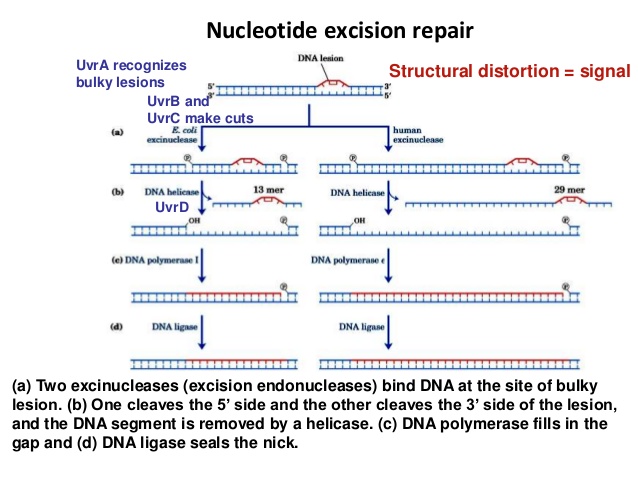
3. Post replicative recombination repair:
- It is a double strand break (DSB) repair mechanism. If a DNA strand contain lesions which prevent base pairing by creating gap in the daughter strand during replication. This causes break in both strand.
- In this repair mechanism, the gap is filled by sequence information from parent strand of sister chromosome by homologous recombination process. The repair of parent strand is done by DNA polymerase I
4. SOS repair:
- Photoreactivation, excision repair and post reactive recombination repair are generally error free repair mechanism. However, there also exist an error prone and mutation inducing repair called SOS repair.
- Error in both complementary strand of DNA would be lethal for cell. Thus SOS repair reconstruct the chemical structure of DNA but the heredity information is lost. Hence SOS repair causes mutation along with repair of DNA. DNA polymerase V help in SOS repair.
- It is also known as inducible repair. It involves more than 40 gene which encodes protein responsible for protection and replication of DNA as well as repair and mutation.
- SOS response have been found in E. coli, Salmonella Typhimurium, Mycobacterium tuberculosis etc, but not in eukaryotic cell.
- It is not a single discrete mechanism but includes diverse responses such as the ability to repair thymine dimers, to induce various prophages, to shut off respiration, to delay septum formation during cell division. These all responses are regulated coordinately.
Mechanism of SOS response: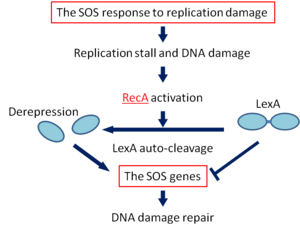
- SOS response is induced when DNA is damaged or when replication of DNA stops and single stranded DNA accumulates.
- Agents such as UV radiations, methyl methane sulphonate, as well as chemicals that damages DNA induces SOS response. Rec A and Lex A gene are major in SOS response induction.
- lexA encodes lexA protein which is repressor. It binds to SOS box near promotor of SOS gene and prevents gene expression.
- RecA protein is a nucleoprotein and is always high in bacterial cell. It form nucleoprotein filaments on single stranded DNA and protects further damage of DNA. Rec A protein acquire proteases activities and activates self-cleavage of lexA protein from SOS box.
- Now the operator and promoter site become free and facilitates gene expression of SOS box gene.
5. Adaptive repair:
- It is an example of adaptive mutation in bacteria.
- Increase resistance to the mutagenic and lethal effects of high dose of alkylating agents has been found in E. coli treated with sub lethal concentration of such agents for long time.
- This resistance is due to adaptive mechanism of repair of mutation. DNA polymerase IV helps in adaptive repair.
References
- http://www.nbs.csudh.edu/chemistry/faculty/nsturm/CHEMXL153/DNAMutationRepair.htm
- https://www.nature.com/scitable/topicpage/dna-damage-repair-mechanisms-for-maintaining-dna-344
- https://www.slideshare.net/aljeirou/mutation-and-dna-repair-mechanisms
- https://www.ncbi.nlm.nih.gov/books/NBK21114/
- https://www.khanacademy.org/science/biology/dna-as-the-genetic-material/dna-replication/a/dna-proofreading-and-repair
- http://www.bx.psu.edu/~ross/workmg/RepairDNACh7.htm
